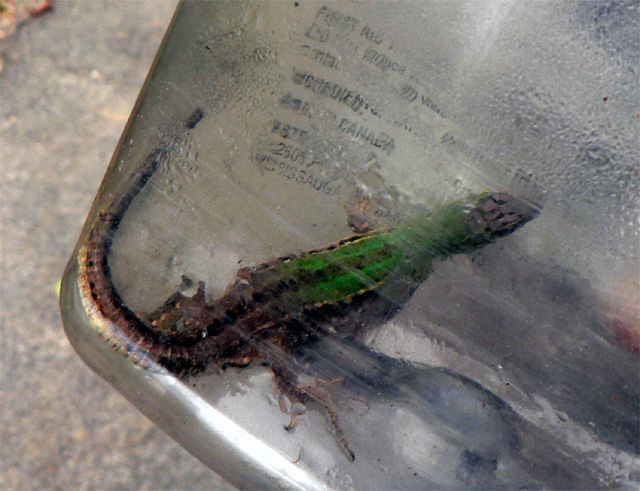Giant Italian Lizards Invade Queens!
When we first visited Ridgewood Reservoir back in April, a local told us that there were hundreds of large lizards at the site in the summer. That was hard to believe since New York has almost no native lizard species (in fact, only two, both skinks). You occasionally see an escaped pet iguana; but they never make it through the winter. However today on our fourth trip to the site we found one of the rumored lizards and trapped it in a bottle so we could get a closer look:

Al Ott identified this as an Italian Ruin Lizard, a.k.a. Italian Wall Lizard, Podarcis sicula. Rob Jett also recognized it from a trip to Rome. They’re an invasive species that has been settling small colonies on Long Island for the last three decades or so, and they’re expanding. So far all we have is this one specimen, but I suspect we’ll see more as the summer progresses.
How they make it through a New York winter I have no idea; but apparently they can do that, something few native American lizards can do.
Besides the lizard and various plants and insects, we tallied over 30 species this morning:
- Great Blue Heron
- American Woodcock
- Rock Pigeon
- Mourning Dove
- Chimney Swift
- Downy Woodpecker
- Northern Flicker
- Eastern Wood-Pewee
- Willow Flycatcher
- Great Crested Flycatcher
- White-eyed Vireo
- Warbling Vireo
- Red-eyed Vireo
- Black-capped Chickadee
- House Wren
- American Robin
- Gray Catbird
- European Starling
- Cedar Waxwing
- Yellow Warbler
- American Redstart
- Common Yellowthroat
- Eastern Towhee
- Song Sparrow
- Northern Cardinal
- Red-winged Blackbird
- Common Grackle
- Brown-headed Cowbird
- Baltimore Oriole
- House Finch
- American Goldfinch
- House Sparrow
The highlights for me were the White-eyed Vireo and the American Woodcock, both possible nesters at the site. We confirmed Downy Woodpecker and Northern Flicker as definite breeders here. We elevated several other species from possible to probable status. (The more often you see them in the same spot, and the longer they stick around, the more likely it is they’re breeding.)
We’ll visit a couple of times more before the breeding season is over to try to confirm a few more. American Redstart is tantalizing. There were quite a few around the site, and this is quite late for them, but they’re late breeders. If they’re still around in July–I’ve never seen them that late in the city–they’re almost certainly breeding.
The city has finally noticed the site, which is not a good thing. When the parks department gets a little money, they like to erect buildings, install pavement, lay out a few ballfields with artificial turf, let the dogs run everywhere, and generally eliminate anything that a breeding bird might want. They’re a couple of meetings later this month on the 19th and 30th (don’t know where yet) at which the Parks Dept. should reveal their plans for the site. They’re a little peeved that word of the meetings is getting out. They’re required by law to open these meetings to the public, but they try to keep them as quiet as possible to make sure no one notices anything they’re up to until the bulldozers arrive. Drop me a line if you’re interested in attending, and I’ll let you know what’s up as soon as I have more details.

July 7th, 2007 at 1:28 PM
[…] Louisiana. Nonetheless this year I’ve added two new species to my reptile list. First the Italian Ruin Lizard and now this beautiful Fowler’s Toad. (Well, maybe you have to be another toad to see the […]
September 3rd, 2007 at 2:49 PM
I walked around the Ridgewood Reservoir, along the dam’s walls and on the outside
bicycle path. I did not see any Podarcis nor did I hear any either.. Today was sunny
and warm with a cool breeze.. Are they shy ?
August 28th, 2012 at 7:06 AM
TODAY IS 28AUG I HAVE BEEN PUTTING UP WITH THIS LIZARD INFESTATION HERE AT MY HOME AND THROUGHOUT MY NEIGHBORHOOD FOR AT LEAST 3 TO 5 YEARS,,THEY ARE GETTING BIGGER AND LONGER,WHAT CAN I DO TO GET RID OF THEM,,OH THEY SURVIV THE WINTER ALRIGHT..